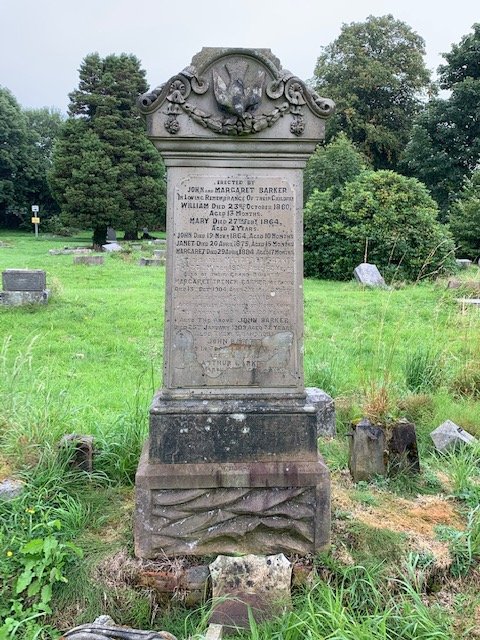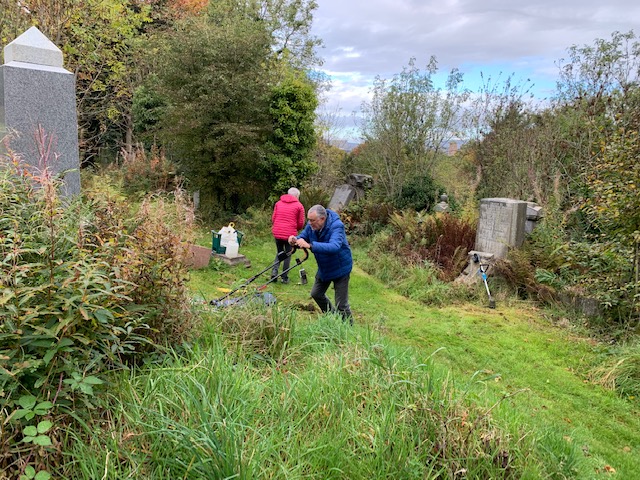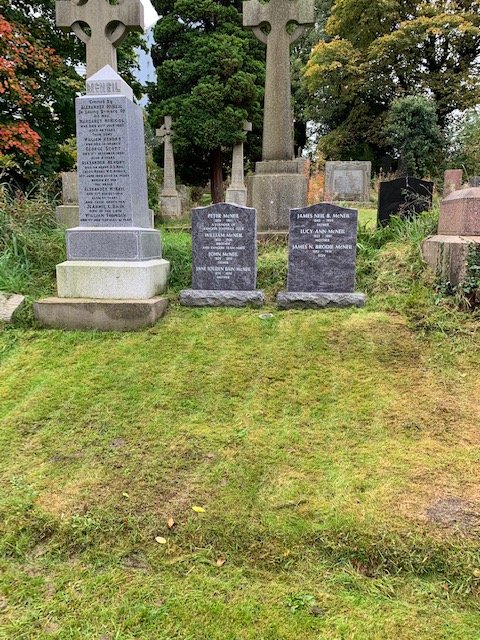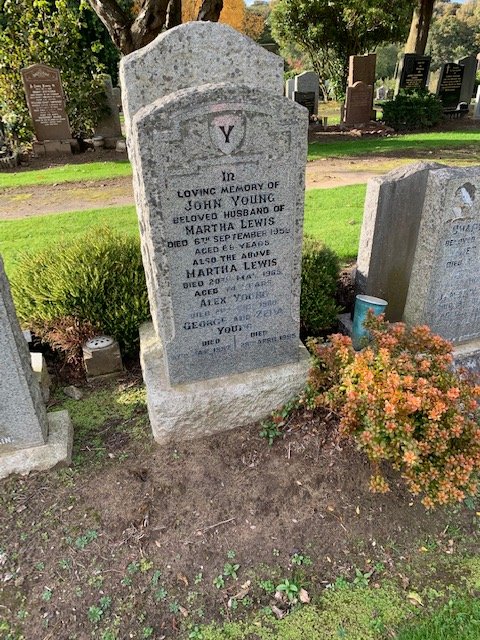

The Moonlighter
-
Posts
1,192 -
Joined
-
Last visited
-
Days Won
3
Everything posted by The Moonlighter
-
On the 29th October 1855 our Founder Moses McNeil was born. image upload Moses was from the east side of the Gareloch ,his father John was from Comrie in Perthshire and mother Jane Bain from Downpatrick in Ulster. He was a natural athlete Powerful and of stocky build,it was said that was known for his pace and he had stamina too. In the Ibrox trophy room is a cup won by Moses for a half-mile race at the Garelochead Athletic Sports on 1 January, 1876 and it’s the oldest Trophy that the Club has. image upload Moses played for the club he helped form for ten years, playing in the 1877 and 1879 Scottish Cup Finals. He was also a member of the first Rangers side to lift a trophy, the Glasgow Merchants Charity Cup in 1879. He actually left Rangers to join his brother Harry at Queen’s Park for a few months at the end of 1875 but quickly returned to his club. He was the first Ranger to play for his country, in a 4-0 victory over Wales at Hamilton Crescent Partick in 1876 and was capped again,when Scotland defeated England 5-4 at First Hampden Park in 1880. For a great deal of his playing career, he formed the Rangers’ left wing with his old friend and fellow Pioneer,Peter Campbell. Although being a member of committee during his playing days, he had little involvement after his football career was over.He did feature, though, on a number of occasions with his old pals in the Rangers “Ancients” team who played many exhibition and charitable matches. Moses led a nomadic lifestyle mainly due to his 20 year employment with the company Langs whose name was synonymous with the famous brand of whisky.Their premises which Moses worked from was on Union Street in Glasgow. During his time in Glasgow Moses lived at 169 Berkeley Street and 333 Dumbarton Road.These locations are among many others that we visit during the Founders Trail. During research for the Gallant Pioneers book an elderly lady was interviewed who until her recent passing still lived next door to Moses old house at Clynder on the shores of the Gareloch . As a little girl back in the early 1930’s she could recall him being known around the village as “The Rangers man’’, and that he was always very dapper in his suit and bowler hat. It was said that Moses would travel to Glasgow once a month to collect his pension, most likely from the Club, and then return later in the day with a spring in his step and a slur on his speech! image upload He spent the last few years of his life living with his sister, Isabella, in Clynder at Craig Cottage. She died in 1935, to be followed by her brother, the last of the siblings, in 1938. They lie together with their sister Elizabeth and Isabella’s husband, Duncan Gray, in the lovely churchyard at Rosneath. But sadly for the man who gave Rangers their name his own wasn’t inscribed on the family headstone. This was due to Moses being the last of the family in the area and there wouldn’t have been anyone around to add his name to the stone. The late,great Sandy Jardine was a great supporter of the Founders project. We knew that Sandy had been working on having a plaque with Moses name on it placed at the churchyard at Rosneath.On Sunday 28th June 2015 as part of the Rangers Graves Restoration Project a plaque bearing the name of Moses McNeil was unveiled at Rosneath Cemtery at a dedication ceremony conducted by Parish Minister Christine Murdoch. A memorial is now in place for a lad who fought so hard to establish the Rangers during those turbulent early years. image upload image upload Moses McNeil packed a bag in 1871, left Rosneath, and headed to industrial Glasgow seeking employment.What he actually did was help form a football club that was to become the world’s most successful and would affect the lives of millions worldwide for generations to come….that continues to this day. Today we remember Moses McNeil.
-
4
-
As we continue to remember and honour our legends and fellow supporters we recently made contact with the family of Rangers great and record goal scorer Sam English. A memorial plaque will now be placed in his name at Cardross Crematorium. Alfredo with the Sam English bowl, awarded annually to our top goal scorer. Update to follow. photo sharing photo sharing
- 1 reply
-
2
-
Two weeks ago we placed at plaque at Daldowie Crematorium in memory of Brian Hutchison.His brother Tommy has shared his thoughts. Our brother. I remember one of my 1st Rangers presents, a tracksuit, my best Christmas present ever, when it got wet in the rain I was lucky to be able to walk in it never mind run, it just soaked up the water but i loved it. Birthdays and Christmas presents after that I would ask for a new strip, boots or a mouldy. Anyone who got hit in the inner thigh with a mould master will be cringing reading this. I even remember a wet bladder with laces coming through the air and thinking should i duck or knock myself out? All we did at the time was kick a ball from morning to night. A ball at your feet on the way to school and home again, any chance we had, at school playtime was kicking a ball, sometimes it was just a tennis ball because full sized balls where banned in the playground, at dinner time we headed to the pitch for a full game. I wasn’t very good so sometimes didn’t get picket to play, I would be devastated but couldn’t show it. One of my classmates was so good he went on to play for Rangers , I’ve always been proud of that and would tell anyone who would listen. In those days we would leave the house in the morning wether we where going to school or during school holidays and our parents wouldn’t expect to see us until we wanted fed at night. There was no danger, nothing bad ever happened or so a lot of us thought. There where atrocities happening not far off but we wouldn’t hear about that for a few years. I remember my brothers going to Rangers games years before i was allowed to go and looked forward to when I could go. My older brother was 3 years older than me and my eldest brother 3 years older than him. I was 13 when me and my mate upstairs started to go to Ibrox, i know this was young and i would never let my kids do anything like this at that age but it was a different time. We would get the bus from the east end into glasgow then walk from the town over to the stadium and get a lift over the turnstiles. We would take in the atmosphere and enjoy the games standing on our tippy toes to see by the big people. We would join in with the songs that we had heard from a lp record on our radiogram in the living room. You would find yourselves beside older guys who would relieve themselves into beer cans or miss them and wet someone else’s trousers. When you left the stadium,being small you could get lifted off your feet with the crowd, we didn’t think much of that at the time but looking back now know how dangerous it was. After the game we walked back to the town centre and got the bus back to the east end, my big brother would have already been back home on the supporter bus, got changed and went out again. My big brother would go on a supporters bus that left from a local pub, he would follow The Rangers every week home and away. When he came back he would tell me about the places he had been watching the Gers. I answered our new phone a few times and it would be a girl from Dundee or somewhere else i had never been, asking for Brian. We shared a room and the walls where full of Rangers pictures. We would cut pictures out of the papers or magazines that we could get at the time. I remember getting excited about my 1st old firm game and I was looking forward to it for ages, we would talk about it all the time. I knew my brother was going to the game with my mates big brother, we went our separate ways all of us buzzing for the game. Most reading this will know what happened at the game but at the time we had no idea(no mobile phones, no internet, no social media. We made our way home to the east end after the game the usual way. Coming off the bus we walked up towards our street, i could see the window open in our flat, remember it was January, it was cold, and saw my mum at the window, when she shouted “where’s Brian”? I knew something was wrong and ran up to our 1st floor flat. I was told that there was a newsflash on tv and fans had died at Ibrox, i was 13 and I didn’t think that anything could have happened to him. My thoughts where that he had went to a pub or met a girl or his mates. My mum wouldn’t let me go,she held me close for a while hoping the phone would ring and it would be Brian calling to say he was with a mate or a girl and he would be late home. It was confirmed to dad by the police that Brian had been one of the fans who had died. Anyone who has had a loss will know how things went after that. The daily record had a picture of Brian with a headline that said, the boy who lived for Rangers At the time you could leave school at 15 and Brian had started working at the shipyards in govan and a lot of his fellow workers,neighbours and friends turned up for the funeral, they lined the path from our house to the road where the hearse was waiting. The coffin had a Rangers crest made from flowers on it. Brian was cremated at Daldowie crematorium, Willie Henderson who was a hero of mine at the time was at the ceremony as a representative of the club. I cant help think it must have been hard for players to go to so many funeral services, one of my heroes was near to me and it could have been anyone. At my age I’ve had many losses since then but i don’t think anyone should go to see their favourite team and not come home. I don’t say the words to him but I’m glad i still have another brother with us. Thanks Iain and anyone involved who work hard to keep doing this great work.
- 1 reply
-
1
-
Today in Dunfermline Cemetery we found the final resting place of Rangers great Sandy Archibald. All efforts will now be made to restore the final resting place of a true Rangers legend. Sandy Archibald Rangers 1917 - 1934. Appearances (all competitions) 625. Goals (all competitions) 159. 13 League titles 3 Scottish Cups 9 Glasgow Cups 10 Charity Cups 8 Scotland Caps. Rangers Hall of Fame Inductee.
- 1 reply
-
1
-
Our full range of merchandise, including our Gallant Pioneer books,is available to purchase here on our website. All orders are posted out within 24 hours. https://www.thefounderstrail.co.uk/shop
-
The winner of Richard Gough’s bike is Richard Burns who has been notified. Congratulations Richard! A wonderful £355 was raised via the raffle for the Restoration of Rangers Graves project.This will help to ensure that our work continues over the coming weeks. Thanks very much to Stevie Cochrane who donated the bike and to everyone who participated.
-
To be in with a chance of winning this incredible prize just donate £10 to the Restoration of Graves Project via this link.The more donations you make the more chance you have of winning. PAYPAL LINK. - https://www.paypal.com/sendmoney ***Follow the link and add following email address along with donation – sonsofstruth@aol.co.uk The winning name will be drawn on Tuesday 20th October. We’ll get the bike delivered to the winner. Good luck everyone!
-
A wonderful £230 has already been donated via this raffle. To be in with a chance of winning this incredible prize just donate £10 to the Restoration of Graves Project via this link.The more donations you make the more chance you have of winning. PAYPAL LINK. - https://www.paypal.com/sendmoney ***Follow the link and add following email address along with donation – sonsofstruth@aol.co.uk The winning name will be drawn on Tuesday 20th October. We’ll get the bike delivered to the winner. Good luck everyone!
-

The Restoration of Rangers Graves Project. George Young.
The Moonlighter replied to The Moonlighter's topic in Rangers Chat
We were delighted to recently find the final resting place of Rangers legend George Young in Grandsable Cemetery in Grangemouth. We now need to locate his family with a view to restoring the stone. Can you help? If you know of any relatives that could approach please call us on 0790 2855536 or email us on thefounderstrail@gmail.com. -
This is the raffle to top them all! Richard Gough received this bike at Ibrox during the mid 1990’s when Coca Cola sponsored the League Cup( he accepted it on behalf of a team mate),understandably Goughie left it behind so it was duly put in Jimmy Bell’s Alladin’s Cave.When the football department moved to Auchenhowie Richard’s bike ended up in the main switch room at Ibrox.Fast forward 20+ years and the bike is taken into safe storage by Rangers employee Stevie Cochrane when he retired from Ibrox.Stevie has now made an incredible gesture and has gifted “Goughie’s bike” to raise funds for the Restoration of Rangers Graves Project,we thank him sincerely. Richard Gough said” I’m delighted that after all these years my bike is being used to raise funds for such a great cause” The bike has never been used on the road but a safety check is recommended. To be in with a chance of winning this incredible prize just donate £10 to the Restoration of Graves Project via this link.The more donations you make the more chance you have of winning. PAYPAL LINK. - https://www.paypal.com/sendmoney ***Follow the link and add following email address along with donation – sonsofstruth@aol.co.uk The winning name will be drawn on Tuesday 20th October. We’ll get the bike delivered to the winner. Good luck everyone!
-
Update. We recently met with the Great Grandson of John Barker. Last Saturday his stone at Craigton Cemetery was cleaned and a memorial plaque placed at the base.
- 1 reply
-
1
-
We’d like to sincerely thank everyone who followed followed in the footsteps of our Founders today all in the aid of the Restoration of Rangers Graves Project. It was a glorious day in Glasgow as we made our way from Fleshers Haugh to Burnbank to Kinning Park and finally home to Ibrox.Along the route we stopped at a few locations and told the incredible story of those kids who formed the worlds greatest football club. A wonderful 8.5 miles completed without the aid of a refreshment break! ? All monies raised will be duly counted and the grand total posted. Thanks to all again.
- 1 reply
-
1
-
As our work on the Rangers Graves Restoration Project continues we were delighted to be contacted by the Great Grandson of Rangers player and Director John McPherson.He informed us that Mr McPherson was buried in Craigton Cemetery and asked us to take a look at his plot. After a bit of searching we managed to locate the final resting place of Rangers ‘’ first superstar’’John McPherson. Sadly the plot was unmarked. Thanks to your continued support of the Restoration Project through your donations a new stone was put in place today, this gives John McPherson back some dignity and respect. John McPherson deserves nothing less. Appearances: 218. Goals: 121. Honours: 5 League titles – 1890/91, 1898/99, 1899/1900, 1900/01, 1901/02 3 Scottish Cups – 1893/94, 1896/97, 1897/98 9 Scotland Caps. John McPherson. THERE have been some hugely talented players who have pulled on the Light Blue over the decades and it is fair to say that John “Kitey” McPherson was the club’s first superstar. The recruitment of the Ayrshireman coincided with the formation of the Scottish Football League in 1890 and he became a huge figure in what was a highly successful era for Rangers. Indeed, he made the kind of start that dreams are made of. He scored on his Rangers debut – a 5-2 win over Hearts – scored four times in his second game, a 6-2 thumping of Renton, and then hit five goals in the 8-2 demolition of St Mirren. It was an unbelievable start, but it was no flash in the pan. McPherson was a pivotal player in 12 years on the field and subsequently a skilled administrator of the Club. He actually played in every position for Rangers, including goalkeeper, but it was as an inside forward that he shone brightest scoring goals as well as setting them up with tremendous regularity. He was part of the first Championship-winning team when Rangers and Dumbarton shared the inaugural Scottish League title. The two sides had finished level on points and the authorities ordered a play-off which finished 2-2 so a share was a declared. McPherson was captain by the time Rangers achieved one of their main ambitions, to win the Scottish Cup. They had not been in the final for 15 years when they faced Celtic at Hampden in front of 17,000 in 1894 and, fittingly, McPherson scored the third goal in a 3-1 victory over the team that was fast becoming their main rivals. Jock had scored in every round on route to the Final as Rangers finally claimed the prize seen as the Blue Riband of the Scottish game. McPherson was on the score-sheet again when Rangers won the trophy for a second time in 1897 when Dumbarton were thrashed 5-1 and a year later the old trophy was retained when Kilmarnock were beaten 2-0. Season 1898/99 was astonishing to say the least and McPherson was a key man in a league campaign that has never been equalled anywhere in the world. Rangers won all of their 18 league matches scoring 79 goals and conceding just 18. It was the perfect league championship win and McPherson played in 15 of the games, scoring seven times. It was the start of a wonderful stranglehold of the Scottish title and the team that did it is undoubtedly on a par with the great sides that dominated the 1920s and 30s, the late 1940s, the early 1960s and the 1990s. With McPherson at the hub of it all, Rangers retained the title in 1899/1900 by seven points from Celtic. He only missed two matches the following season and scored seven times as the title remained at Ibrox for a third successive year, And then Rangers made it four in a row in 1901/02, McPherson’s final season in the first team. Incredibly, his final league appearance was as goalkeeper in the 3-2 win over St Mirren on January 18 1902 – a match Rangers had to win to hold off Celtic for the title – as regular keeper Mathew Dickie was injured. It’s a bit like Brian Laudrup replacing Andy Goram! McPherson had been a massive player in a fantastic era for Rangers. In 1907 he became a director of the club and served until his death in 1926. He collapsed and died while watching the Clyde Sports at Shawfield and one contemporary described him as “the finest player in the first 50 years of the club’s history”. Today we remember John McPherson.
-
1
-
No guys we aren’t taking up arms... ?? This is Jean and Les who are the Restoration of Rangers Grave Project gardeners.They work tirelessly at keeping the plots of our legends at Craigton Cemetery in pristine condition. The worldwide Rangers support says thank you ??
- 1 reply
-
2
-
RANGERS have been fortunate to have had some fantastic captains in their history and there are many who believe that George ‘Corky’ Young was the greatest of them all. He earned his nickname because of the lucky champagne cork he carried in his pocket, but it hardly seems an appropriate nickname for a man who stood 6ft 2in tall and weighed 15 stone. Young was a massive man in every sense and his influence on both Rangers and the national team was colossal. Originally a centre half, Young moved to right back to allow Willie Woodburn to fill the central area. They were two of the six men who comprised the famous Iron Curtain defence. He had many qualities – most obviously as a tough defender. He was awesome in the air and a fierce tackler, his long legs often preventing the opposition breaching the Rangers backline. His fitness was such that between autumn of 1948 and the summer of 1953 he missed a mere five league games out of the 150 that Rangers played. But perhaps his greatest ability was to turn defence into attack with incredible speed. He could launch a ball 60 yards or more with minimum of effort and it invariably found the front men, and players like Willie Waddell and Willie Thornton thrived on the breakaway. Young and Rangers won six titles in ten years, including the treble in 1948/49, mostly battling with the great Hibernian team of the era. The Edinburgh club won three titles and finished runners-up to Rangers on three occasions. Young also collected two Scottish League Cup and four Scottish Cup winner’s medals – none quite so fulfilling for him as the 4-1 victory over Clyde at Hampden on 23 April 1949 when he scored twice from the penalty spot. Such a career is bound to earn admirers. Eric Caldow, a teammate initially and subsequently a great captain himself, was in no doubt about Young’s standing in the grand scheme of things, saying: ‘He had a fantastic presence at the back and was a natural leader. Every player looked up to him and had everything you could wish for in a defender. He was a big man who was good in the air, was a fierce tackler and also had a lot of skill. He was a truly great Rangers player.’ John Greig, a fantastic skipper in his own right in the 1960s and 1970s, added: ‘George epitomised what being a Rangers captain was all about. He was known as the “Gentle Giant” as well as “Corky” and although he was a very imposing player, he was a fair one.’ Young played 53 times for Scotland, appearing in 34 consecutive matches at a time when there were far fewer international matches than there are today. Indeed, it took nearly two decades for his caps record to be surpassed. He led Scotland a record 48 times but his influence was far more substantial than any captain of the modern day. Basically, Young ran the Scottish side in the days when committees picked teams and there was no manager. Remarkably, he arranged training, theatre visits and even booked local transport for the team. He announced he would play his final game for Scotland against Spain in Madrid on 26 May 1957 – but, cruelly, the selectors did not pick him. During his playing days and beyond he also ran a coffee shop with goalkeeper George Niven in Glasgow’s Hope Street which was a popular haunt. And when he left Rangers at the end of the 1956/57 season, and stopped playing the game, he began to concentrate on his hotel business. He returned to football for a few years in the early 1960s to manage Third Lanark. George Young sadly passed on the 10th January 1997.
- 1 reply
-
1


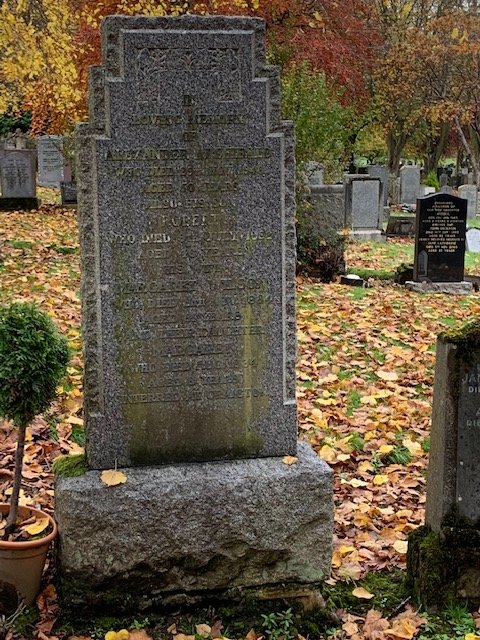
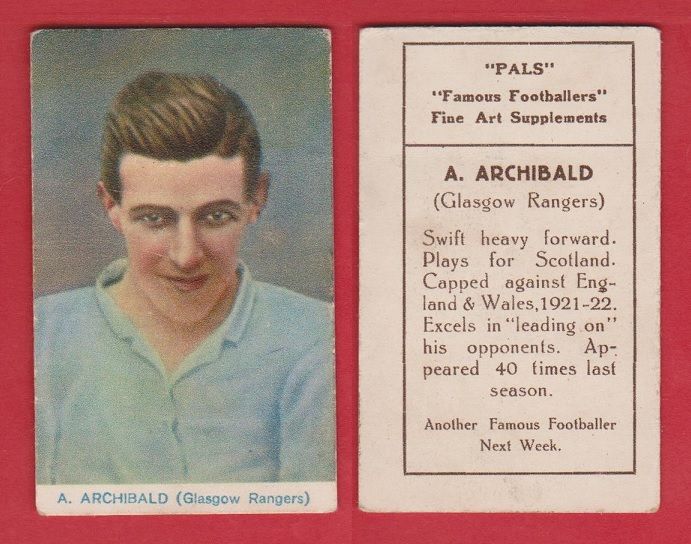

.png.c2b710e7232e98652346e4bc5ee79694.png)
